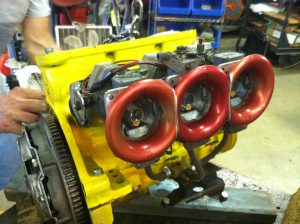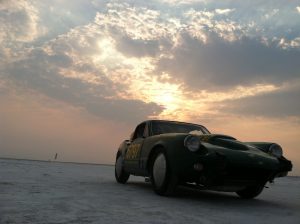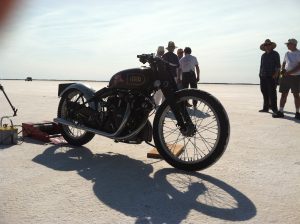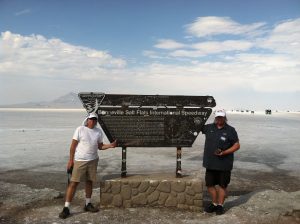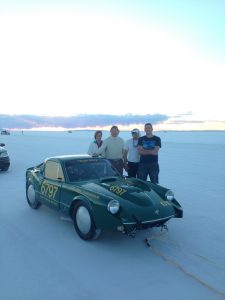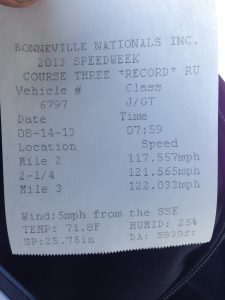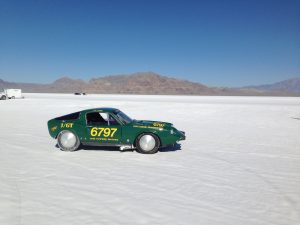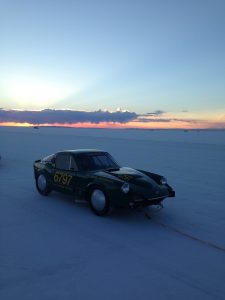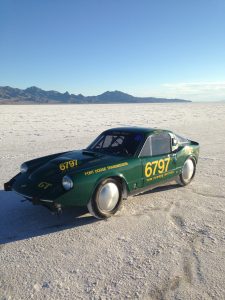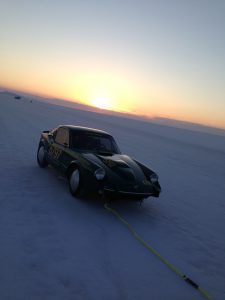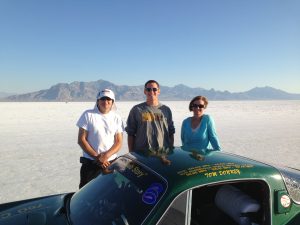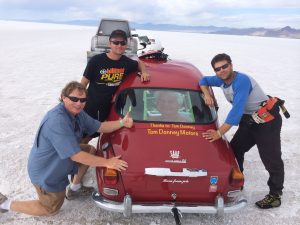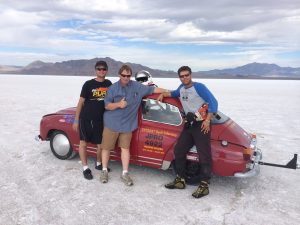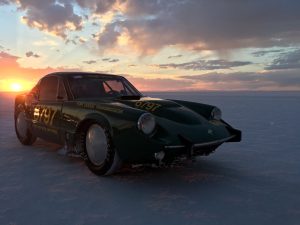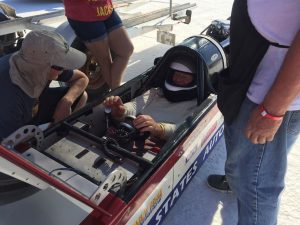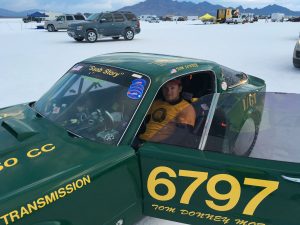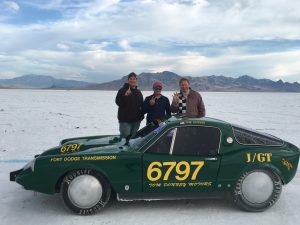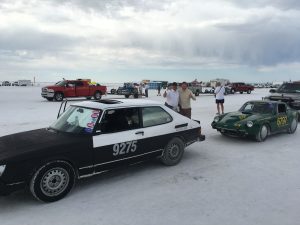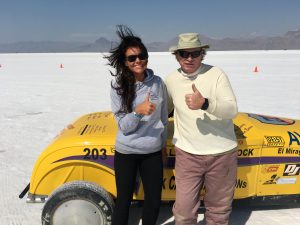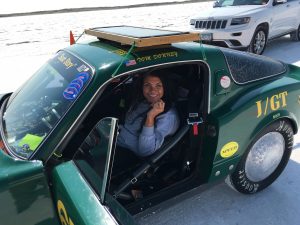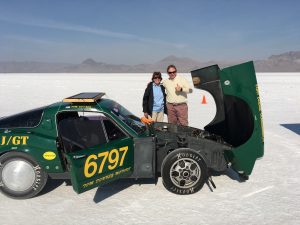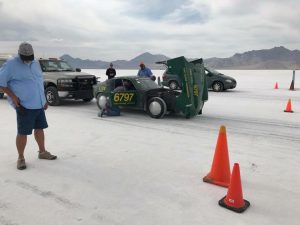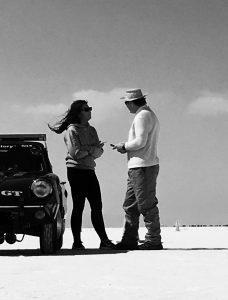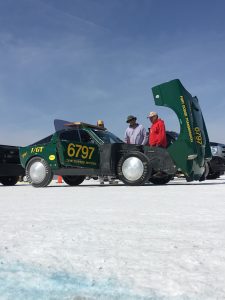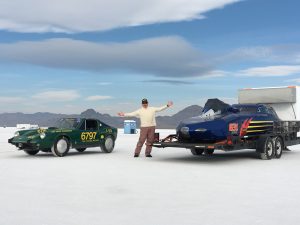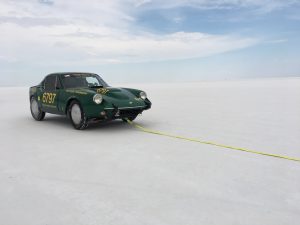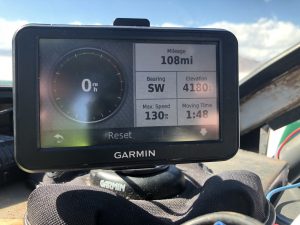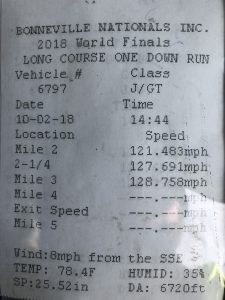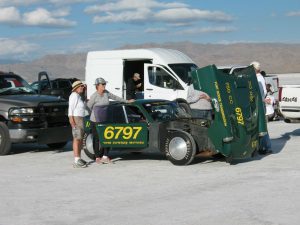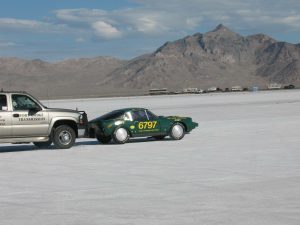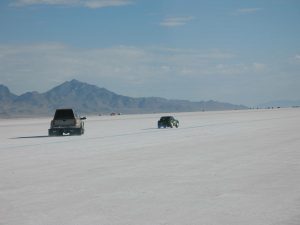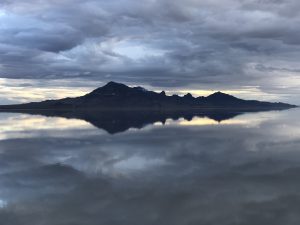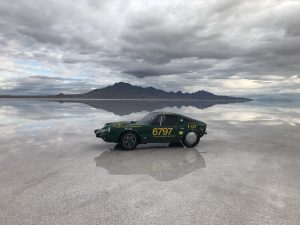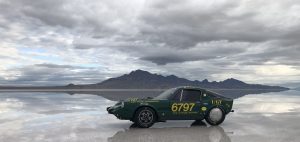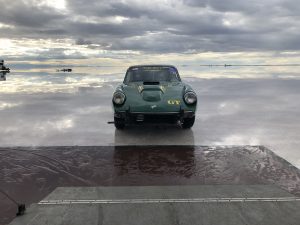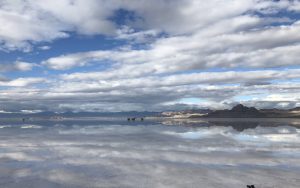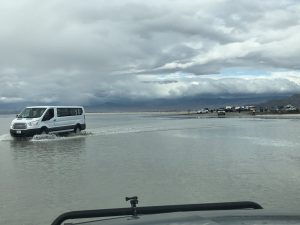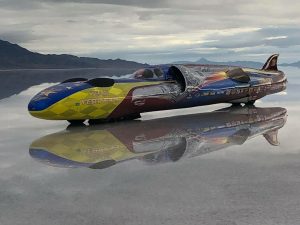August 15, 2011, we set new and first record at 98.968 MPH
August 17, 2011, we re-set our record to ……..105.613 MPH
August 18, 2011, our final record was set at 107.443 MPH
In 2012 we started out to break our own 2011 record of 107.443 MPH
August 13, 2012 we set a new record at 109.514 MPH
August 15, 2012 we re-set our record to 115.619 MPH
Bonneville Salt Flat Nines 2012
Bonneville Salt Flats VSCNA 2012
This video is from our return record setting run on Wednesday, August 14, 2013. We hit over 122mph
Our Vintage 1968 Saab Sonett II breaks it’s own World Land Speed Record for 750cc engine (“J Class”) and even EXCEEDS the 1,000cc (“I” Class record) with a return run of 122.033 MPH at Bonneville International Speedway August 14, 2013. This 750cc two stroke engine was putting down over 100HP to the wheels on a Mustang Chassis dyno. It’s hard to see but my iphone (Speed app) is on the left next to the red battery kill switch. The shift to 4th is at 95mph and I am at 109mph by mile 1. I am at 120 mph by the start of mile 2. Exit speed was 122 mph +.
The busy crew just as we were told “start your engine!”…..the excitement is still there!
Good results from Bonneville this year. With an almost all new pit crew, David Roe, Issac Poldervarrt, and my wife Patti we jelled into a real “pit team” and Bumped our record 3 times!!
We ran in the GT body class again this year (2 seat sports car).
Our engine is a “J” class (501cc- 750cc) upto 46CID)
They take the average of 2 runs over 2 day (down & back runs to set a record)
Our 2012 record was 115.619 mph.
We set new record on 8/11/13 of 118.082 mph (down=117.236 & return=118.929)
On 8-13-2013 we bumped our record to 119.291 mph (down=119.503 & return=119.080)
On 8-14-2013 we bumped our record again to 121.203 mph. (Down = 120.374 & return = 122.033)
The 122.033 mph run on 8-14, was our fastest speed.
The 122.033mph exceeded the next engine class size (“I”) record for engines upto 1000cc!
That is rare to see when a smaller engine exceeds the record of the large engine!!
They however would not let us run as an “I” class car because our engine was “too small” 🙁
Last year, and even early in the week this year, they said we could Run as an “I” class with our smaller engine. Rule interpetation is very hard.
After that we set everything up to the edge of “go or blow” since we only had 1 day left and it takes two days to set a record. No luck on final 2 runs as they heat of the day (99 degrees) got the better of us.
The funny thing is our fastest top speed (still only 750cc ) engine still sat in the trailer and we never swapped it out. Once we were informed we could not run our 750cc engines in the 1,000cc class we lost interest with the heat to swap it “just for fun”.
More to come later……………….Thanks to all who follow us!! Tom
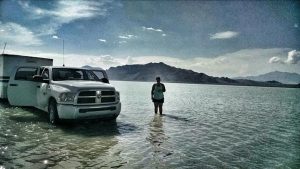
Heavy rains turned the Salt flats into “Lake Bonneville” again and forced the cancellation of Races in August.
2014 was a strange year in Deed. It begin with the unexpected death of my salt racing friend Bertil Sollenskog the end of June. Then the races in August were cancelled shortly after we arrived with 2 cars, Our Sonett and Bertil’s Monte Carlo. Then again in October they were cancelled again due to wet weather at the salt.
But conditions did dry up enough the first week in September for Races to be run by the Utah Salts Flats Racing Association. And we showed up with Bertil’s Monte Carlo to attempt to set some new records for his crew and his widow Pat.
I was able to set a new record of 111.472mph on September 6, 2014 and Finally Bertil’s main driver set the last and final record of 112.642mph on Tuesday, September 9, 2014.
We are very grateful for Pat to allow us to run Bertil’s car and for his crew to be there to set the new records. It took a lot of work from many people, as you would expect from anything worth doing.
More articles published in different magazines to come later……..tom
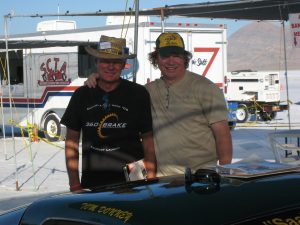
Happy times with my friend Bertil after BOTH of us set new Land Speed records at Bonneville in 2011.
Happy Moments after we finally got Pavel his Land Speed Record in Bertil’s car at Bonneville. September 9th, 2014. See the photo of Bertil in the rear window “riding shotgun”. (Mike is in the black shirt)
Fat Man in a little car…Tom
Driver Steve Myer of Ames Iowa Isaac Poldervaat, Steve Myer & Tom showing 124mph
A Tale of Salt (And Saabs!)
After Speed Week was cancelled due to heavy rains and flooding in 2014* and 2015 we finally got back to the salt this past August 2016. We were fortunate enough to have the SOC16 (Saab Owners Convention) a week before Bonneville this year. Usually the dates collide and I choose the salt as a year of prep can not go to waste. This allowed me to attend SOC16 in Atlanta and a great track day with one of three cars to run at Talladega Speedway back in 1987. In 1987 Saab set 21 world and international speed records at Talladega with Saab’s world famous LONG RUN RECORDS. As many in the Saab community know, I was asked to bring my #3 car (1987 Saab 9000) back to Talladega to run. This was almost an impossible event to miss for me, so that said we did the killer trip to Atlanta and then raced back to Iowa to grab my truck and trailer and head to Utah! Going to SOC is always a great event and should be a “must do” for Saab lovers. Seeing old friends and making new ones keeps SOC’s a fun event. Many well wishers at SOC were seen and heard. Leaving for Iowa after SOC was a speedy trip home only to gear up for round TWO…a date at the salt.
To explain how hard it is to prep and run a car at Bonneville, read about the work of Dan Haugh of Kansas and his 1987 Saab Classic 900 at the salt. The salt can be a grueling event with heat into the high 90’s and long hours at the “brightest place on earth”….the hot sunny salt flats. Dan set a new record of 140.857 MPH (Down run of 139.620 & Record run of 142.095 MPH) with his turbo powered 2.0L car and explains in his articles in NINES about the stress of attempting to do all this at Bonneville. Dan is busy making modifications for 2017 already. Dan had also ran at the Ohio Miles and has records there with his classic Saab too.
The trip to Atlanta and back to the salt was pulled off without issues so we arrived in Bonneville a day early and setup our pit camp. That allowed us to take a much needed day off on Friday the 19th. Unfortunately for me my long suffering back went out and landed me on the trailer and hotel floor laying as much as possible. I gutted out the next few days determined not to let my back “win”. I did get blessed with a much better back on Monday and keep it at bay till the day back home in Iowa when it finally said ENOUGH and gave up on me for good. (Note I did have experimental back surgery with the “installation” of a new artificial disc (ADR) in my L4/L5 region in Texas this past October. As of this writing I am doing very well)
We started running as planned on Saturday morning the 18th as planned. I was the driver and glad for it as the salt was less than perfect. We ran fast but not quiet fast enough. There were a mirage of small issues limiting our success the first 3 runs. We had starter issues twice, once at the starting line, an electric water pump failure, our brakes completely failed (only use rear), and finally a rough track that kept us bouncing all over the course. Even though we had good runs only 3/10’s and 7/10’s of a second off our old record of 121.203 MPH we just could not get above 122 MPH.
Once we sorted all these issues out on our forth run we finally hit our goal with an average mile speed (set from mile 2 to 3) of 122.295 MPH and qualified to have another chance at a record run!. On our fifth run the next morning we were able to attain a NEW Bonneville Land Speed record of 123.075 MPH (with our 750cc engine. To date this is the fastest average mile we have ran with a return speed of 123.855 MPH (199.325 Km/h) Top (terminal) speed was actually over 124 MPH). After resetting our record it was time to change drivers (great news for my back) to Steve Myers of Skunk River Restorations in Ames, Iowa. Steve races nearly every weekend somewhere and was an exciting and experienced last minute add to our team when my service manager at the shop took ill and and had to cancel a week before leaving. My wife Patti, was very relieved when she heard Steve had agreed to go as it got off the hook as an emergency “back-up” crew member. With a new driver in place it was time to continue to crawl our way up the speed ladder with a vintage our Saab Sonett two stroke.
As it turned out the salt Gods we not with us the last few days. My crew chief, Steve Myers, got his rookie training done and first runs out of the way. Waiting in line for his second real run we started to notice the wind was changing and had a chance for a tailwind. (Which would have aided in exceeded my newly set record). However as luck would have it, at 4pm, when we were only two cars from running, (after a 4 hour waiting) racing was postponed due to heavy Crosswinds that had now came up. Then at 6 PM they canceled racing for the day. (Which ultimately cost us a new record.) The next day Steve DID exceeded my new record with a down run of 123.397 MPH which sends you to impound till the next morning for a “back Up” return/record run attempt. But the return/record (back up) run the following morning was not to be. A weather system change arrived and we had to run into an 11 MPH headwind, and we simply could not get the Sonett back into record territory. That cancellation of racing we had two days earlier put us into the headwind days and cost us the new record.
We ran a few more times that day but the headwind was too great and the forecast for Thursday afternoon and Friday was the same, lots of headwind. So we loaded up and left with only one new record of 123.075 MPH. We had hoped for more, but obviously we are always happy ANYTIME we can set a new land speed record at the Bonneville Salt Flats. As the final records for the week long event came in, turns out the weather and salt produced the LOWEST number of records being set in modern memory. But this year did include getting to see Danny Thompson FINALLY set a land speed record at Bonneville @406.767 MPH (655km/h). He is the son of the late Micky Thompson and drove his dads 1968 twin engine Challenger II into Bonneville history books.
If you look at the record book of all the different records you’ll see that we are running faster than almost any “J” engine (501-750cc) has EVER ran in a non-blown, Non-altered, GAS category. Also we are consistently running faster than many of the “I” engine (751-1000cc) which are 250cc higher! (We actually have a higher record than the I class above us currently in the GT category!)
Also I did have two things happened this year I NEVER thought I’d say back in
2010 in a Saab Sonett powered by a 750cc two stroke engine!
1st. “I Could only go 114 MPH…at half throttle” (Throttle cable
slipped out of place and limited throttle to 1/2 opening)
2nd. “…121 MPH is all I can do” ……..
1st 3 runs of 2016…All good fun in an old Saab.
Thanks for reading and Safe Saab’in, Tom Donney
* In 2014 World of Speed (ran by the Utah Salt Flats Racing Association) did find enough
dry salt to run a 4 day event even through Speed Week
(ran by the Southern California Timing Association) was cancelled for rain.
Both groups honor each others records.
|
|
 |
ReplyForward
|
The year 2018 is a bit of a “lost year” for me and Patti. Setting up a Saab museum is a full time job by itself. Let alone transporting 150 plus cars and literally “tons” of shop supplies and equipment to operate it. Taking 10 hours each way to haul trailer loads of Saab stuff from Fort Dodge, Iowa to Sturgis, SD is a daunting task. So having time for “fun stuff” was ruled out for 2018. Job ONE is the museum. But Chuck Andrews helped haul 100 cars out from May to July which was a “God Send” for me and Patti. But even with Chuck’s help I told Patti in early July that running at Bonneville Salt Flats seemed out of the question this year. I had been trying to figure out a way to perform a magician’s “hat trick” and pull a couple rabbits from my Sonett hat. But that seemed to be impossible for 2018. To be successful at Bonneville you need to have more horse power than the previous year to set a new record. For me that takes a lot of dynamometer time. Usually 75-150 Dyno “pulls” as we call test runs. But the Saab museum has consumed all of my time this year and any spare time I have needs to be spent addressing issues at my transmission business.By mid August I was working on a possible “hat trick” and I told Patti I had one chance to produce more horsepower on the Dyno with our “best guess” modifications. Problem was I only had 3 days to do the testing & mods! One mistake and the rabbit would die. Also even if you keep everything the same on a two-stroke engine, but you increase the bore size, typically intake and exhaust modifications must be modified too. So just increasing the bore does not give you extra horsepower like a four stroke. That said we made one attempt to increase horsepower on the dyno & we did! We got lucky. That gave us just enough added horse power to potentially exceed the “I Class” record of 122.539 mph.Also, if I failed at added HP, I had one more rabbit I could pull out of my hat. And that was to “Hop up” a class and run in the LARGER engine size class of 751cc-1000cc. I like the saying, “figures don’t lie… But liars figure”. Because of all the speed we have managed to obtained on our small 750cc engine we were now running a faster average mile speed record in “J Class” at 123.765 mph, then the “I Class” with a 1000cc engine at 122.539 mph. That meant if I could just make my engine a few CC larger and keep everything the same I would have a chance to set a new record in the “I Class”. Maybe I had found ONE rabbit hopping around!So with 2 rabbits in our hat we set off in September for “World of Speed” 2018. I had three main goals for the trip. First was a new world record. Second was to obtain my 125-149 MPH license. Lastly was NOT to blow up my engine! I took along my service manager Chuck Crimmins and my lead Saab tech Will Roberts along to help pit.It took a few runs as we missed the first run by .023 of a second from qualifying. The next two runs were lost to a throttle cable stretching and then breaking! But on the next run we eventually squeezed just enough power to exceed the “I Class” Record of 122.539 to a very slim NEW RECORD of 122.679 mph (That is the average speed for 2 runs, for the 2-3 mile run, over 2 days).With our first goal accomplished it was time to tackle the next 2 goals. The problem was they tend to collide with each other since we could only get to 122.5+ mph. But in Bonneville you either break records or break parts. And to go over 125 mph was going to require a delicate dance of carb mixture, timing, compression ratio and fuel choice. I have a friend named Howard who is my “go to guy” for two stroke racing turning. We talked Sunday night on the phone and crunch the numbers. He felt the engine “might blowup” with these new settings, but I hoped I could get to the 3 mile mark before it melted down! Running wide-open throttle for 3 straight miles is a strain on any engine! My pit crew was a bit divided on which way to go. Young Will Roberts had been campaigning to make the changes and “go for it”. Both Chuck and myself thought we were at the end of our power output with the 752cc engine and exceeding 125 was not possible. Chuck and I went for a walk and told young Will to decide on his own. If we came back and the changes were in the process of being made we would compete the next day. If not we would head home and spend more time on the dynamometer to find the needed horse power to exceed the 125mph mark without blowing up an engine immediately!When Chuck and I returned to the pit “Will Power” had taken over! Will was making the delicate changes and we would see what the morning would bring.The next day the car ran faster than it ever has! As I entered the 2 mile I was already over the speed of 124 mph. And this GPS monitored speed just kept climbing! We ended up with an exit speed of 129mph and a run of 127.763 mph for the 1 mile average speed. The second rabbit had finally been pulled out of the hat! We had discovered a new formula to make the small engine run even faster then we thought it was capable of.We did our back up run into a 2 mph headwind which only cost us 2/10’s of a mph. So we ended up with a two run average of 127.660 mph for the NEW “I Class” record! (751-1000cc engines).And the icing on the cake was our engine was in perfect condition. No damage had occurred. It was time to go home!But the story doesn’t end there. Armed with a new formula to make the car run faster we then set our sights on the “World Finals” three weeks later in October with a slightly smaller engine back in our old “J Class” (501-750cc engines).My crew for the “World Finals” consisted of my wife Patti and newfound friends (we had only met a week earlier at the Saab Museum) Reggie & Kitty Pitts of Hill City, SD.We had the right car & the right crew…And FOR A DAY, the right conditions. We ran our FASTEST run ever at 128.758mph. (That is an average speed for 1 mile) with a top speed of 130+mph).However rains came that night and we were unable to run our mandatory “back up run” the following day. Racing was postponed for a day and the course was shortened by 2 miles (from 10 miles to 8) because dry salt was found out in the middle of the course.Unfortunately more rains came that night and what was an already saturated salt became a salt of sea. We were left in impound without a new record. We left our fastest ever run slip hanging on the “Porta potty wall” along with about 18 other race teams that were unable to compete in the newly formed “Lake Bonneville”.We loaded the race car and all of our tools and parts from our pit area in toe to ankle deep saltwater and sadly headed home. But we were encouraged by our fastest runner ever. More importantly Patti and I had felt blessed to have found new friends in Reg & Kit.So never be afraid of hat tricks & rabbits!Safe Saab’in! Tom Donney. |
2019…The year the was NOT to be…
The 2019 Marked the first time in 8 years we could NOT repeat a record. We had 7 runs at the September World of Speed event and NO records. The Gods Of Speed worked against us. Turned out a loose Flywheel was to blame. You chase a lot of issues and sometimes you just have to “reset” and try again.
We solved the issues once home and reloaded for the World Finals in October. On our way to the finals the event was cancelled for rain…and our hope for an 8’PEAT ( 8 years of setting new records) was washed away with the rain.
2020…COVID & The IMPOSSIBLE ENGINE REBUILD!
9/29/2020, Run #1 @126.153mph & melted #2 piston at mile 2 7/8’s mark (Of 3 mile course) Can you rebuild your engine in impound with the 4 hour limit?? YES YOU CAN! A Great Crew and Team work proved it can be done.
9/21/2020 Repaired Engine for Run #2 @125.788mph and a NEW Record of 125.970mph!
The next 4 runs were 125.463mph, 124.276mph, 124.494mph & 124.899mph. We simply could not go faster with our weaken #2 Cylinder. No more rabbits to out out of my hat of tricks.

